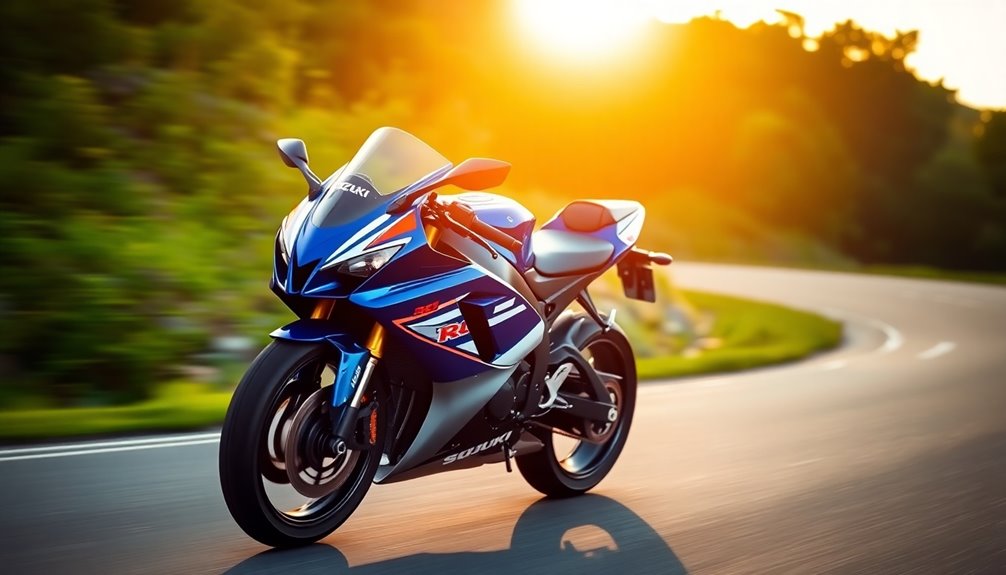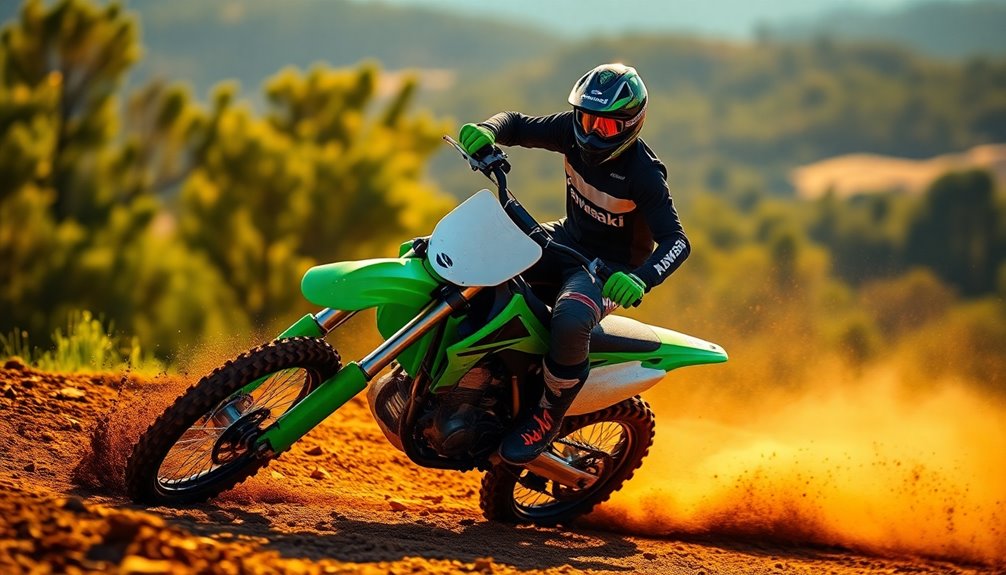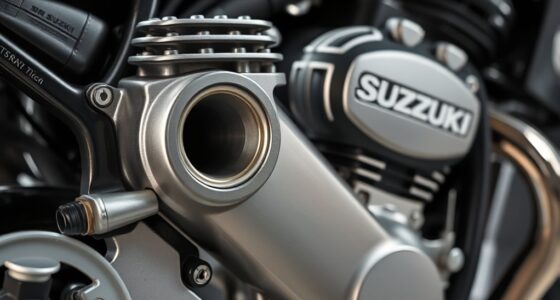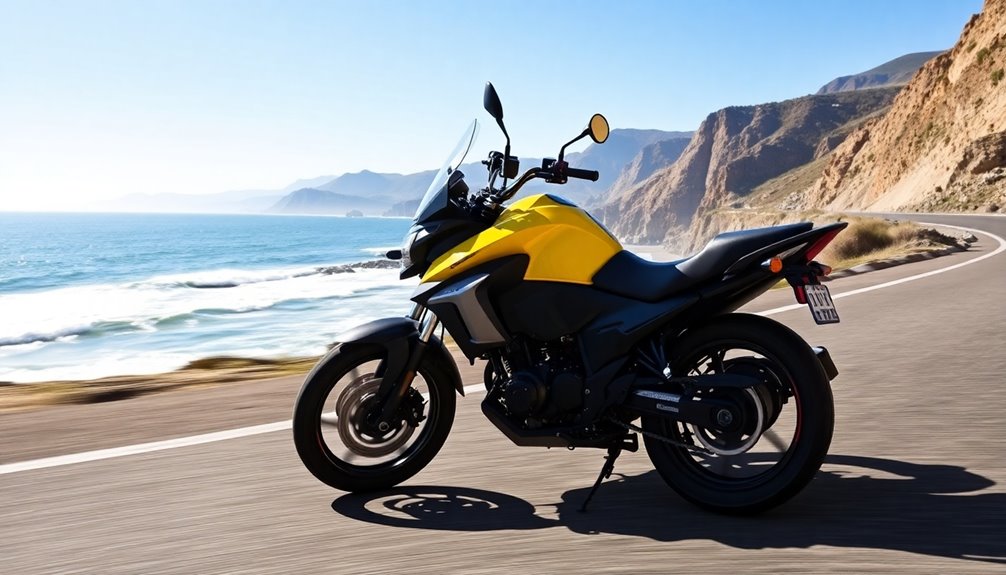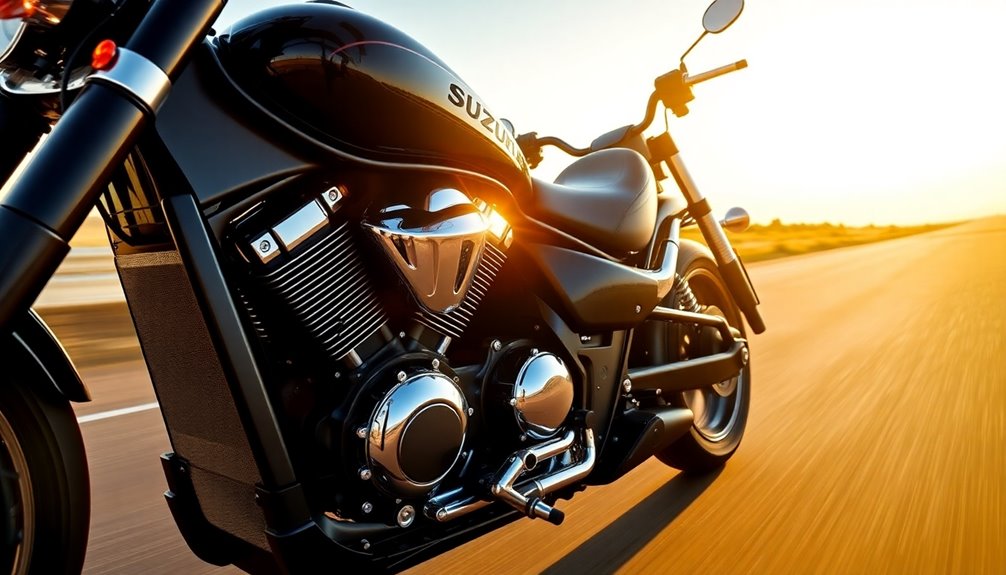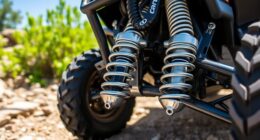The Suzuki GSX-R1000 sets the standard for supersport motorcycles with its exhilarating top speed of 186 mph. You'll love the raw power from its 999.8cc inline-four engine, delivering a staggering 203 horsepower and rapid acceleration from 0-60 mph in just about 3 seconds. Its lightweight aluminum frame enhances handling, while advanced features like adjustable traction control give you confidence at high speeds. Comfort isn't ignored either, with an ergonomic design allowing spirited rides. As you explore further, you'll find even more insights into what makes this motorcycle an iconic choice for enthusiasts like you.
Key Takeaways
- The Suzuki GSX-R1000 boasts a top speed of 186 mph, making it one of the fastest liter bikes in its class.
- Its powerful 999.8cc inline-four engine delivers an impressive 203 horsepower for exceptional acceleration and performance.
- Advanced aerodynamics and a lighter frame contribute to enhanced handling and stability at high speeds.
- Features like Suzuki Variable Valve Timing optimize power delivery, especially below 8000 rpm, for superior throttle response.
- The combination of Brembo brakes and advanced suspension ensures confident control during high-speed maneuvers, appealing to supersport enthusiasts.
Lightweight Aluminum Frame Design
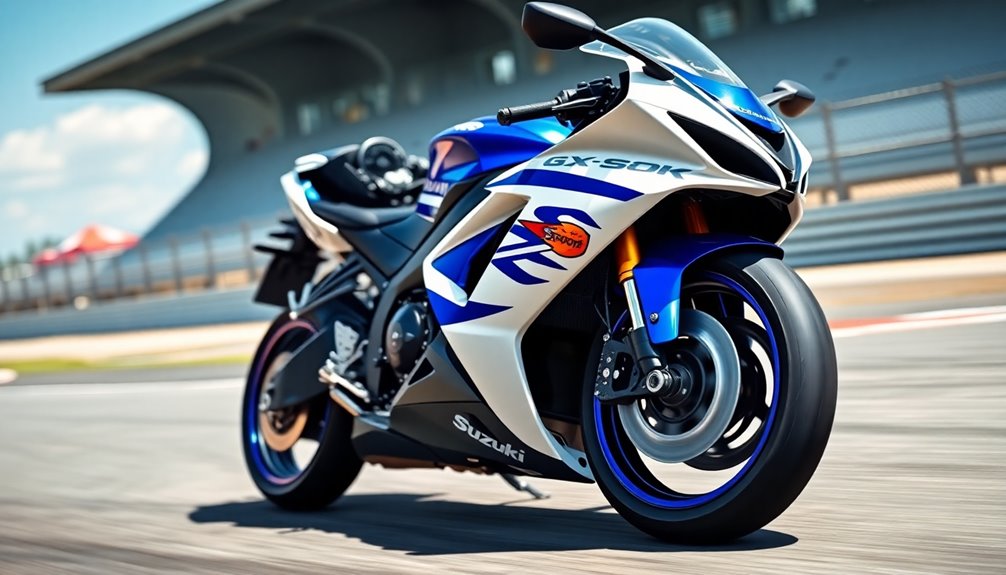
When it comes to performance motorcycles, the Suzuki GSX-R1000's lightweight aluminum design is no exception. Made from twin-spar aluminum, this frame is 10 percent lighter than its predecessor, which significantly enhances your riding experience. The construction utilizes Finite Element Method (FEM) analysis to ensure strength is placed precisely where you need it most, keeping handling sharp and responsive.
The frame's design positions the engine further back, optimizing chassis dimensions and reducing the distance from the fork to the center by 20 mm. This adjustment, along with a 40 mm longer swingarm, improves stability and aerodynamics, allowing you to tackle corners with confidence. Additionally, the GSX-R1000 is equipped with a 999.8cc liquid-cooled engine, which provides smooth, controllable power across a broad rpm range.
Plus, the adjustable swingarm pivots on the GSX-R1000R let you fine-tune your setup for even better performance.
Narrower than previous models, the frame enhances both handling and top speed while bringing comfort to your ride. With the integration of advanced suspension, lightweight wheels, and high-performance tires, everything works in harmony to elevate your riding experience.
The GSX-R1000's frame design is a perfect blend of comfort, stability, and performance, making it a true standout in the supersport class.
Engine Performance Insights
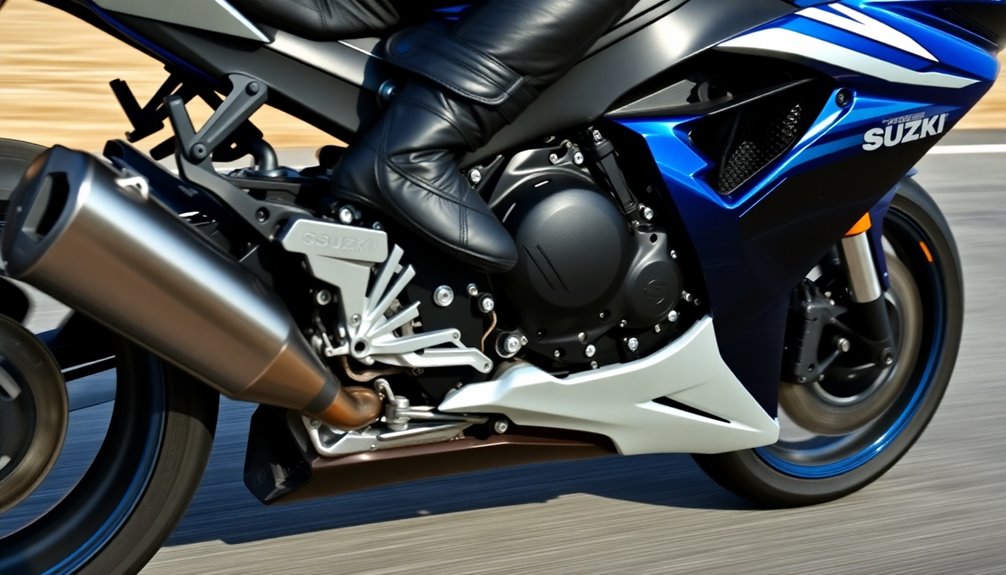
When you hit the throttle on the Suzuki GSX-R1000, you're unleashing serious power, reaching a maximum velocity of 186 mph. You'll feel the rush as it accelerates to 60 mph in just 3 seconds, showcasing its impressive engineering. With advanced aerodynamics and wind resistance design, this bike ensures you stay stable and in control at high speeds. Additionally, the GSX-R1000 features a 999.8cc, 4-stroke engine, which contributes to its remarkable performance and power output.
Maximum Velocity Achieved: 186 Mph
Achieving a maximum velocity of 186 mph with the Suzuki GSX-R1000 showcases its impressive engineering and performance capabilities. This iconic liter bike reaches 183 mph in its stock configuration, demonstrating that you don't need modifications to experience thrilling speeds. However, if you're aiming for the mid-190 mph range, consider upgrading the exhaust system and tuning the bike.
The GSX-R1000's in-line four engine, boasting a displacement of 999.8 cc in the latest models, delivers a staggering 203 horsepower and 117 Nm of torque. This high peak power, combined with efficient power delivery, makes for an exhilarating ride. With a peak torque of 80 ft-lb at 8500 rpm(80 ft-lb at 8500 rpm), the bike offers a wide power/torque delivery across the RPM range.
With advanced features like the Suzuki Variable Valve Timing system and SET-Alpha exhaust valves, you experience optimized performance across the entire rev range. In terms of acceleration, the bike's capability is impressive—reaching 0-100 mph in just 5.53 seconds. Its design, featuring a twin-spar aluminum frame and advanced electronic systems, ensures nimble handling and stability at high speeds.
In a world of modern liter bikes, the GSX-R1000 stands tall, delivering unmatched performance and excitement for any supersport enthusiast.
To 60 Mph in 3 Seconds
The Suzuki GSX-R1000's impressive power isn't just about top speed; it also excels in rapid acceleration. With a 998cc engine for the K5 model and a 999.8cc for the 2023 version, you'll feel the thrill as you push the throttle. The in-line four, four-stroke, liquid-cooled engine boasts a compression ratio of 12.5:1 for the K5 and 13.2:1 for the 2023 model, ensuring robust power delivery.
You can rocket from 0-60 mph in just 3.10 seconds with the K5 model, and the 2017 GSX-R1000R improves that to an astonishing 3.06 seconds. This kind of acceleration is thrilling, making you feel glued to the seat. The Suzuki Fuel Injection system with Ride-by-Wire technology enhances throttle response, allowing you to harness all that power effortlessly.
The GSX-R1000's strong low to mid-range performance means you can outpace competitors like Yamaha R1 below 8000 rpm. In addition, the 2023 model is powered by a 999.8cc liquid-cooled inline-four engine, making it a true contender for any supersport enthusiast. When you're on this bike, every twist of the throttle translates directly into exhilarating speed, making it a true contender for any supersport enthusiast.
Aerodynamics and Wind Resistance
While you ride the Suzuki GSX-R1000, its aerodynamic bodywork significantly enhances performance by minimizing wind resistance. Designed through extensive wind tunnel testing, the GSX-R1000 presents a slippery shape that not only looks compelling but also improves handling and top speed.
The front fairing is 13 mm narrower, allowing for better airflow around your hands and arms, which translates to more control at high speeds. The lower leading edge of the fairing nose directs air into the Suzuki Ram-Air Direct (SRAD) intake ducts, boosting pressurized air flow to the engine. The engine's backward rotation creates a more stable chassis with a reduced distance from the fork, enhancing aerodynamics further. Additionally, the use of a taller bubble design in the windscreen contributes to improved aerodynamics at high speeds.
Cooling efficiency doesn't take a back seat either. The advanced cooling system uses 400cc less coolant while ensuring optimal temperatures through improved airflow to the radiator. Plus, the shape of the front fender increases downforce, guiding cooling air effectively.
With a lightweight aluminum frame and advanced suspension, the GSX-R1000's design synergizes aerodynamics and performance, ensuring you experience unmatched speed and handling on the track.
Rider Comfort and Ergonomics
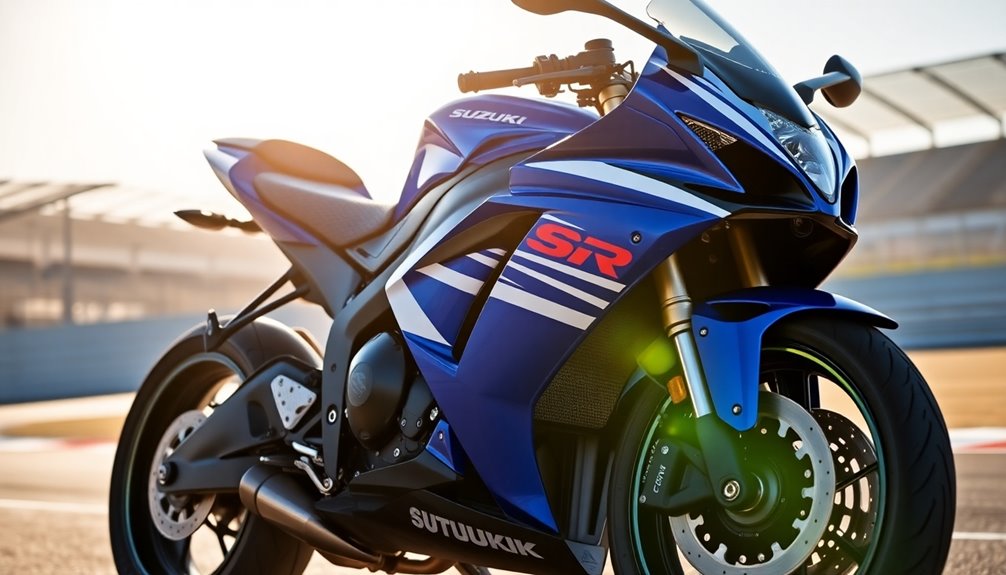
Rider comfort and ergonomics play a crucial role in the overall experience of the Suzuki GSX-R1000. With a seat height of 825mm, riders with a 32-inch inseam can easily get both feet flat on the ground.
The bike features a tight seat-to-peg ratio and an aggressive reach to the clip-on bars, making it ideal for spirited riding. However, this typical superbike-style ergonomics means you might feel the weight shift onto your bars, especially with the stock suspension setup, which can be quite harsh. The harsh suspension can significantly impact comfort during longer rides, making adjustments even more critical.
To enhance comfort, you'll need to adjust the fully adjustable Showa suspension to suit your weight and riding style. If you're lighter, proper tuning is essential to avoid wrist strain and discomfort.
Additional grip on the tank is vital to keep weight off your hands, making core strength important for maintaining a comfortable riding position.
For improved comfort, consider aftermarket accessories like Corbin seats or Tappezzeria Italia seat covers. These options can significantly enhance your experience by providing better support and grip.
Ultimately, achieving the right balance of ergonomics and comfort is crucial for enjoying every ride on the GSX-R1000.
Owner Satisfaction Ratings
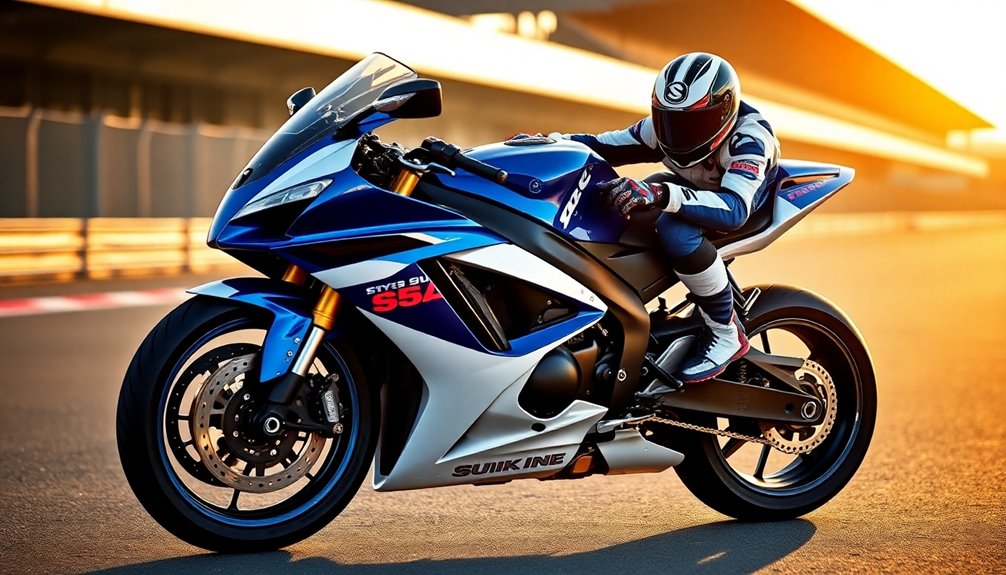
Owner satisfaction ratings for the Suzuki GSX-R1000 reveal a generally positive outlook among riders, particularly regarding its performance. With an average rating of 3.66 out of 5 from 514 evaluations, many riders appreciate the bike's impressive driving experience. It scores an almost perfect 4.9 points for performance, highlighting the engine's power and handling in diverse conditions.
Owners frequently praise the GSX-R1000 for its lightness and robust power delivery, especially in the low to mid-range. The bike's acceleration and top speed—0-60 mph in just 3.10 seconds and a top speed of 183 mph—are standout features. The Suzuki GSX-R1000R competes in the 1000cc Supersport class, further emphasizing its position as a top performer in the market.
Electronic controls, such as the Motion Track Traction Control System, enhance safety and handling, receiving positive feedback. However, some criticisms arise, particularly regarding the quick shifter, which some riders find challenging to master. Additionally, issues with ETC card access and strong engine braking noise have been noted.
Market Positioning Against Rivals
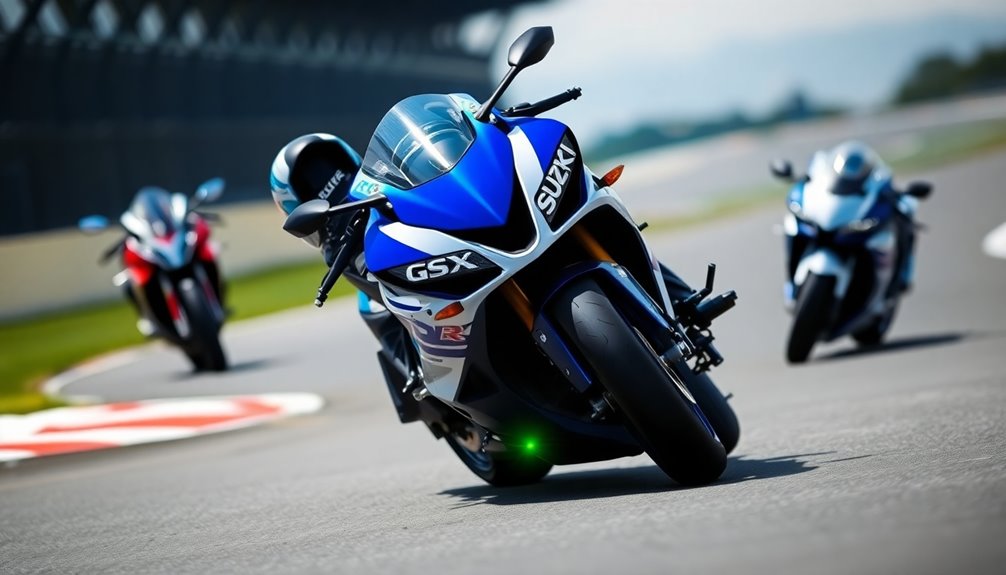
In today's competitive supersport motorcycle market, the Suzuki GSX-R1000R stands out for its impressive blend of power, performance, and affordability. With a 999.8cc inline-four engine producing 197PS, it may not lead the pack against rivals like Honda's CBR1000RR-R Fireblade at 218PS or Yamaha's YZF-R1 at 200PS, but it offers a smooth power delivery thanks to Suzuki's Even Firing Order Engine and the innovative Suzuki Racing Variable Valve Timing System (SR-VVT). Additionally, the GSX-R1000R's 988cc inline four-cylinder engine design is renowned for its power and reliability.
When it comes to pricing, the GSX-R1000R is the most affordable in its class at 2,156,000 yen, significantly undercutting competitors like the CBR1000RR-R Fireblade and Yamaha's YZF-R1.
While some rivals offer more electronic features, the GSX-R1000R still boasts advanced technology like adjustable traction control and the Suzuki Bi-directional Quick Shift System, providing effective handling.
Its lighter twin-spar aluminum frame and advanced suspension enhance maneuverability, making it a strong contender in the supersport segment.
With a comfortable riding position and aerodynamic design, the GSX-R1000R effectively balances performance and comfort, ensuring you have a thrilling ride without breaking the bank.
Performance-Enhancing Tuning Options
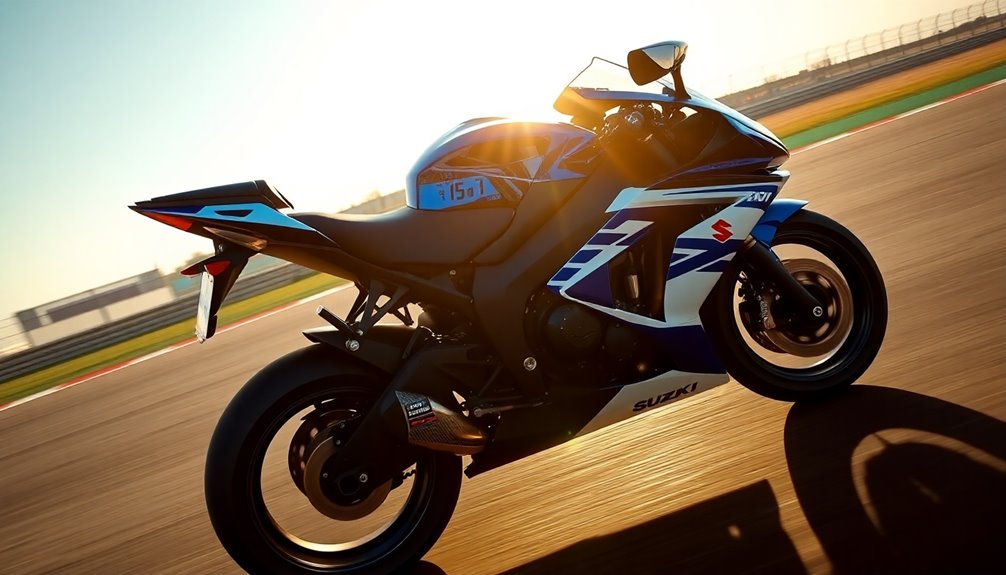
When you're looking to maximize the performance of your Suzuki GSX-R1000R, exploring various tuning options can significantly elevate your riding experience.
Start with engine modifications; disassemble and inspect your motor for any issues, then perform CNC porting and a valve job to enhance flow. Optimizing the compression ratio by milling the cylinder head can also boost power output. It's essential to ensure that all engine components work in harmony to prevent catastrophic failures.
Next, consider electronic tuning. A reflash of the ECU, like the BrockFLASH ECU Stage 1-F, can unlock significant performance improvements. Adjusting fuel maps ensures your engine modifications work in harmony, while de-restricting the ECU removes factory limitations.
For top-tier performance component upgrades, install velocity stacks for improved airflow and high-performance valve springs for better valve control. If you're serious about weight reduction, titanium components can provide strength without the heft.
Lastly, consider tuning packages that cater to your needs. A Stage 1 package offers basic enhancements, while a Stage 3 package includes extensive modifications for unprecedented power.
Don't forget to use recommended fuels and lubricants, like VP Racing Fuels and MOTUL, to ensure your engine runs at its best.
Cost Comparison With Competitors
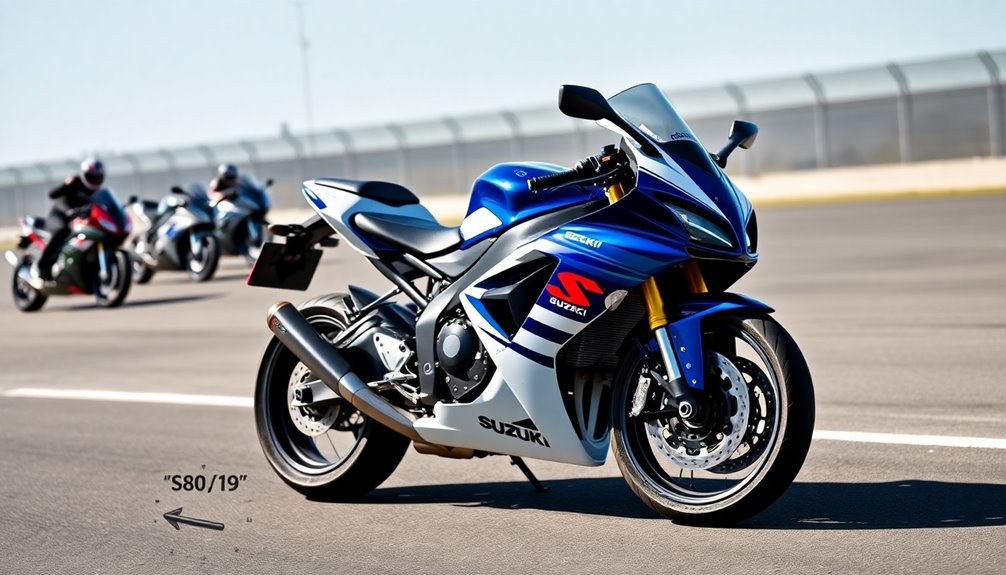
The Suzuki GSX-R1000's pricing positions it as a strong contender among its rivals, especially when compared to the Yamaha YZF R1, which is just slightly less expensive. At ₹19,84,732, the GSX-R1000 offers a compelling mix of performance and features that appeals to many riders.
The YZF R1, priced at ₹19,83,531, comes with advanced electronics and a powerful 998cc engine, making it a worthy opponent. Both models share the same engine capacity of 999.8 cc, ensuring that performance is on par.
However, if you're looking for a more budget-friendly option, the Honda CBR1000RR Fireblade at ₹17.61 lakh stands out as a cost-effective choice, albeit with slightly lower performance metrics.
The Kawasaki Ninja ZX-10R takes the crown as the most affordable option at ₹16.4 lakh, delivering excellent value for money without skimping on performance.
In this competitive landscape, the GSX-R1000 and YZF R1 are closely matched in terms of features and price.
Ultimately, your decision may hinge on how you balance performance with cost. If high-end performance is your priority, both the GSX-R1000 and YZF R1 justify their price tags, while the Ninja ZX-10R offers great features for less.
Track-Focused Performance Enthusiasts
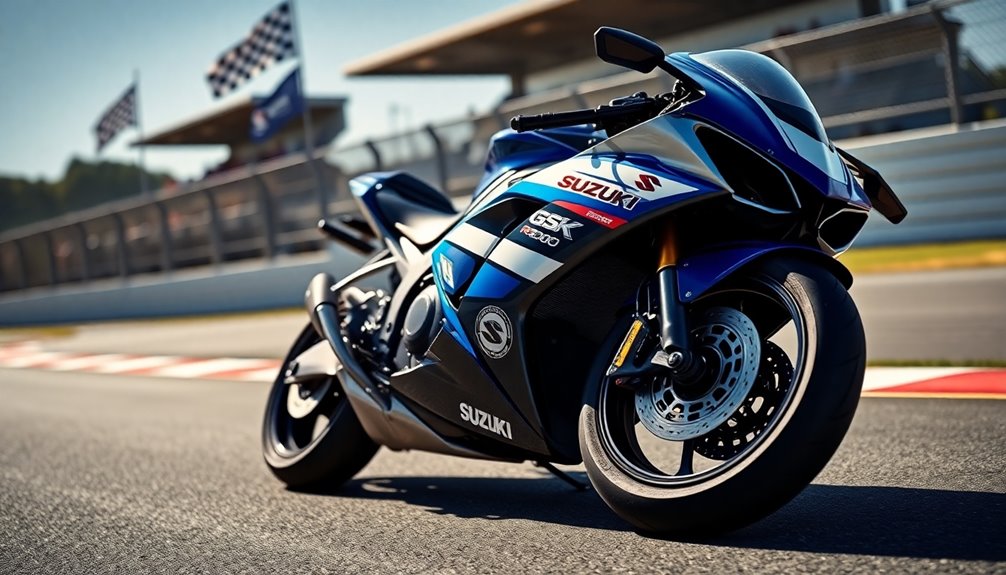
For track-focused performance enthusiasts, the Suzuki GSX-R1000 delivers an exhilarating blend of power, precision, and advanced technology.
With a robust 999.8cc inline-four engine, you'll experience class-leading power that's smooth and controllable across a broad rpm range. Accelerating from 0-100 mph in just 5.53 seconds, this machine ensures your adrenaline stays high throughout every ride. The 2017 GSX-R1000 model introduces a completely rebuilt engine aiming for 200bhp, further enhancing its performance potential.
The GSX-R1000's chassis design is optimized for precise handling, featuring a narrower frame that enhances stability and top speed. The aggressive rake and trail settings provide a rock-solid stable chassis, making it perfect for those tight corners on the track.
Coupled with Bridgestone Racing Street RS11 tires, you'll notice improved high-speed cornering performance that enhances your overall experience.
Aerodynamically designed, the GSX-R1000 utilizes wind tunnel-tested bodywork for an ideal balance of speed and aesthetics.
The advanced electronic features, including traction control and cornering ABS, give you confidence in your braking and acceleration, allowing you to push your limits.
With the GSX-R1000, you're equipped to conquer any track.
Frequent Tire Wear Problems
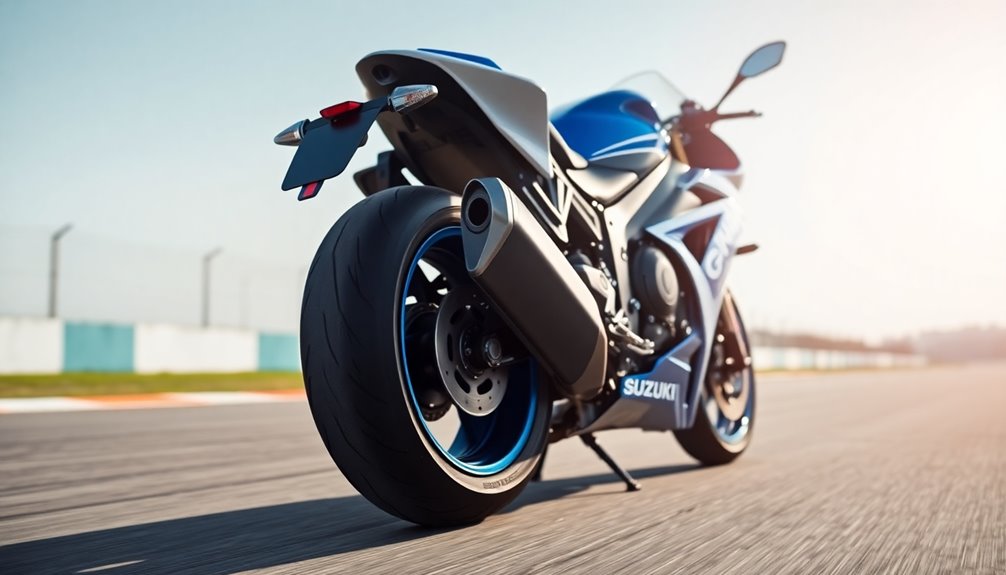
Frequent tire wear problems can significantly impact your performance on the track and overall riding experience. One of the most crucial factors is tread depth; lower tread depth indicates more wear, which can compromise your grip. Additionally, tire age matters—if your tires were manufactured 10 or more years ago, they likely need replacement due to oxidation and hardening of the rubber. Heat cycles also play a significant role. Repeated warming and cooling can deteriorate your tires, making them lose grip even if the tread looks fine. Hot environments can accelerate oxidation, further increasing your wear rate. This is why investing in tire warmers is essential; they help maintain optimal temperature and grip. Regular maintenance is key. Inspect your tires for sidewall cracks, which indicate severe oxidation, and check the tread pattern for wear. If you're using the Bridgestone Racing Street RS11 tires, their design helps reduce wear while maximizing performance. Keep in mind that storing your bike in a hot garage can also contribute to rapid tire degradation. Additionally, the GSX-R1000's advanced electronics can help monitor tire performance and adjust settings accordingly. Check your tires often to ensure they're ready for your next ride.
Advanced Braking System Features
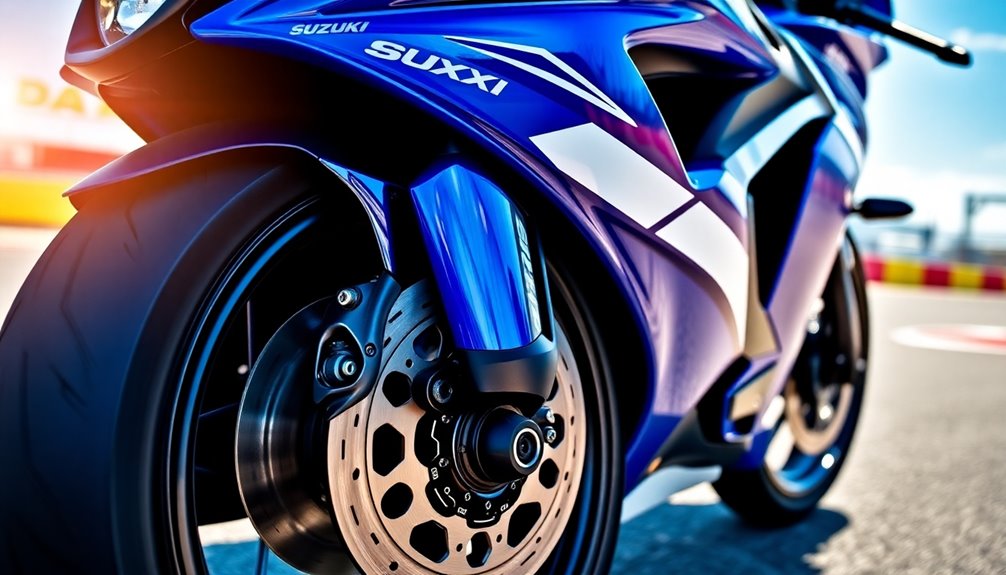
When it comes to enhancing safety and performance, the advanced braking system features of the Suzuki GSX-R1000 stand out. The Motion Track Brake System works in harmony with the IMU, adjusting front brake pressure when it detects rear wheel lift, ensuring you maintain optimal braking efficiency.
You'll appreciate the strong performance from the Brembo T-drive front brake rotors and four-piston radial-mount calipers, which provide unmatched stopping power.
The ABS functionality, while not designed to shorten braking distances, helps you stay in control, especially on uneven surfaces. With the IMU's ability to detect chassis pitch, the system fine-tunes brake pressure when you're leaned over, maximizing tire grip. This system is further enhanced by the advanced technologies integrated into the GSX-R1000 for an optimized riding experience.
The T-drive brake rotors, paired with a robust rear setup featuring a 240mm disc and Nissin caliper, enhance your stopping control.
You'll also benefit from stainless steel brake lines that ensure reliable performance. This advanced braking system combines cutting-edge technology and high-quality components, giving you the confidence to push your limits on the track while prioritizing your safety.
Exceptional Handling at High Speeds
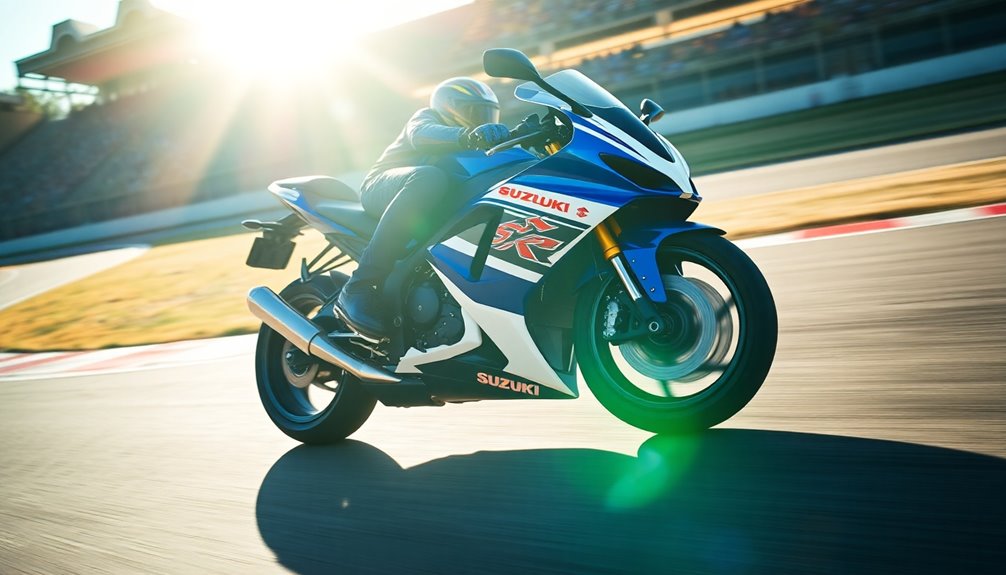
Exceptional handling at high speeds is one of the standout features of the Suzuki GSX-R1000, making it a favorite among sportbike enthusiasts. The bike's aerodynamic bodywork, refined through extensive wind tunnel testing, minimizes drag and lift, allowing you to slice through the air effortlessly. The narrower fairing improves airflow around your hands and arms, enhancing control as you navigate tight corners.
The GSX-R1000's twin-spar aluminum frame is both lighter and more compact, contributing to its agile handling. The frame's geometry has been optimized, with a backward-rotated engine angle and an extended swingarm, which together enhance stability. You'll feel the difference during high-speed maneuvers, as the reduced distance between the front axle and swingarm pivot gives you exceptional feedback. Additionally, the compact chassis design allows for improved front-end feel and braking capabilities.
Moreover, the advanced Showa suspension system provides excellent stability, ensuring you maintain confidence when pushing limits. Equipped with Bridgestone Racing Street RS11 tires, you'll experience improved grip and reduced wear, enhancing cornering performance.
With a powerful engine that delivers smooth, reliable power across the RPM range, the GSX-R1000 truly excels in providing exceptional handling at high speeds.
Frequently Asked Questions
What Is the Top Speed of the Suzuki GSX-R1000?
If you're wondering about the top speed of the Suzuki GSX-R1000, you're looking at impressive figures.
The 2017 GSX-R1000R can reach 189 mph, while earlier models like the K5 hit around 183 mph.
With some modifications, you could push the GSX-R1000R over 195 mph.
Acceleration is equally thrilling, as the GSX-R1000R goes from 0 to 100 mph in just 5.42 seconds, making it a top contender in the sportbike world.
How Does the GSX-R1000 Perform in Different Weather Conditions?
The GSX-R1000 performs impressively across various weather conditions.
In dry weather, you'll appreciate its sharp handling and rapid acceleration.
When it rains, the traction control adapts to keep you stable and in control.
On uneven or loose surfaces, the adjustable suspension enhances your ride quality.
However, in cold weather, be cautious with braking until your tires warm up.
What Are the Maintenance Requirements for the GSX-R1000?
To keep your GSX-R1000 running smoothly, follow its maintenance schedule. Change the engine oil and filter every 3,500 miles.
Inspect the chain and brakes regularly, lubricating the chain every 600 miles.
Check valve clearance and spark plugs at 12,000 miles, and replace spark plugs every 24,000 miles.
Don't forget to inspect the air cleaner every 6,000 miles and ensure proper lubrication of pivot points to maintain peak performance.
Are There Any Common Issues Reported by GSX-R1000 Owners?
Yes, GSX-R1000 owners often report common issues.
You might encounter engine problems like a rich air-fuel ratio or crankshaft failures, especially in 2009-2010 models.
Electrical issues, such as water-damaged ECUs and sensor malfunctions, are also frequent.
Don't overlook maintenance concerns either; oil leaks, clutch wear, and coolant system issues can arise.
Regular checks and proper maintenance are crucial to keep your bike running smoothly and to avoid these pitfalls.
What Accessories Are Recommended for the Suzuki GSX-R1000?
When considering accessories for your Suzuki GSX-R1000, you'll want to enhance both performance and comfort.
Upgrading to a full exhaust system can boost your bike's speed, while a flash tune improves overall efficiency.
For safety, invest in Brembo® brakes and a Motion Track Traction Control System.
Don't forget ergonomic adjustments with clip-ons and tank pads for better handling.
Lastly, choose protective gear to maintain your bike's aesthetics and safeguard its components.
